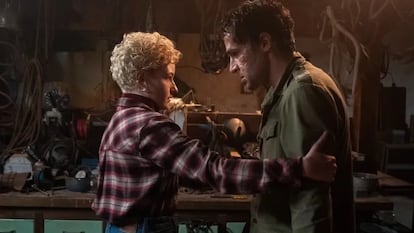Five years ago, the Australian writer and director Leigh Whannell delved into the myth of the invisible man, giving it a twist related to gender violence as imaginative as it was consistent with his own nature: the man in the long coat, gloves and face covered with bandages. From the novel by HG Wells and the handful of film adaptations, the mad and lonely scientist who never let himself be seen became a neurotic of his wife’s control, a spiteful stalker, a man incapable of overcoming abandonment. The tragic contemporary fear of certain women of the sudden appearance of their harassers, who never know when or where they may come from, connected perfectly with the lurking invisibility of Wells’ science fiction character.
Produced by Blumhouse, one of the great firms in horror films of the last two decades, The invisible man (2020) now has a kind of little sister (in every sense) in werewolfwith which Whannell tries to do something similar in terms of social finesse, around the protection of children and family, and the protection of the home, including the couple, in its broadest extent. A film that slips somewhat into action and fear, which are never sufficiently brave or terrifying, but which, with the same elegance in the staging of his previous work, excellent performances and good dialogue in the most intimate sequences, It is important enough not to be ignored.
Since George Waggner’s version for Universal, lycanthropy has always played well in cinema, with translations in all styles (always with terror involved, but sometimes even with comedy, see the eighties Teen Wolf), and fighting in a diverse way, hand in hand with the best special effects of each era, with the almost obligatory graphic representation of the moment of the transformation of the human being into an animal. Perhaps aware that, in this last sense, and despite the passage of time, it is difficult to improve the impact produced in its day by the metamorphoses of the wonderfully refreshing An American werewolf in London (1981), of John Landis, and the storyteller In the company of wolves (1984), by Neil Jordan, Whannell has chosen not to try to compete in that matter, and to focus his attention on its main subtext: the educational one between parents and children, with the help of the prodigious children’s performer Matilda Firth, in the crisis of couple, and in a much more current and egalitarian vision of the family, depending on the circumstances, in which roles are exchanged with a father who is more attentive to the house, and a mother overwhelmed by work who does not feel good enough and loving parent.
Credibly set in the forests of Portland, in that deep America that at some point can remind us of another lycanthropic film set in the peculiar physical, social, economic, temporal and moral space in which it takes place, the magnificent The Wolf Forest (1970), by Pedro Olea, in rural Galicia, werewolf It falls short, however, in the final terrifying climax, when the director opts for an aesthetically ugly preparation of the shot from the point of view of the man already converted into a wolf, and when the emotion of intimacy is far above the brio of the terror.
werewolf
Address: Leigh Whannell.
Interpreters: Christopher Abbott, Julia Garner, Matilda Firth, Sam Jaeger.
Gender: terror. USA, 2025.
Duration: 103 minutes.
Premiere: January 17.

